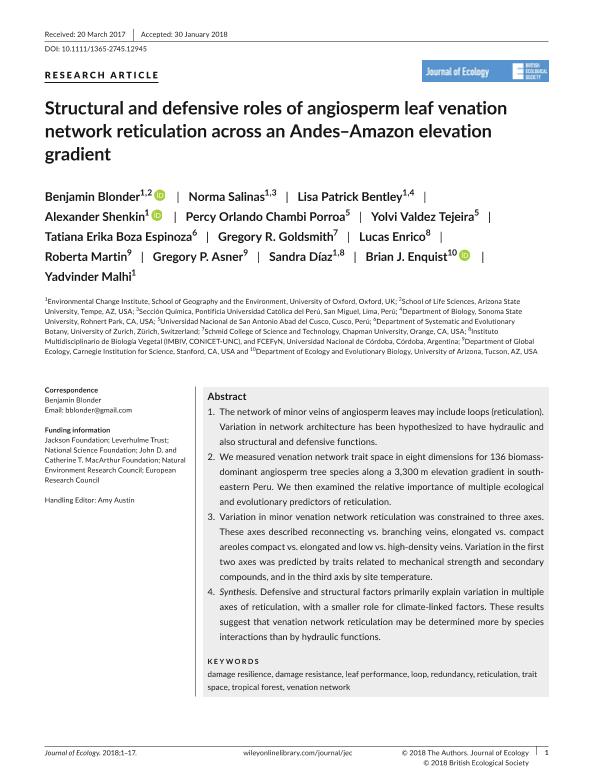Mostrar el registro sencillo del ítem
dc.contributor.author
Blonder, Benjamin
dc.contributor.author
Salinas, Norma Beatriz

dc.contributor.author
Bentley, Lisa Patrick
dc.contributor.author
Shenkin, Alexander
dc.contributor.author
Chambi Porroa, Percy Orlando
dc.contributor.author
Valdez Tejeira, Yolvi
dc.contributor.author
Boza Espinoza, Tatiana Erika
dc.contributor.author
Goldsmith, Gregory R.
dc.contributor.author
Enrico, Lucas

dc.contributor.author
Martin, Roberta
dc.contributor.author
Asner, Gregory P.
dc.contributor.author
Díaz, Sandra Myrna

dc.contributor.author
Enquist, Brian J.
dc.contributor.author
Malhi, Yadvinder
dc.date.available
2019-10-22T14:12:24Z
dc.date.issued
2018-07
dc.identifier.citation
Blonder, Benjamin; Salinas, Norma Beatriz; Bentley, Lisa Patrick; Shenkin, Alexander; Chambi Porroa, Percy Orlando; et al.; Structural and defensive roles of angiosperm leaf venation network reticulation across an Andes–Amazon elevation gradient; Wiley Blackwell Publishing, Inc; Journal of Ecology; 106; 4; 7-2018; 1683-1699
dc.identifier.issn
0022-0477
dc.identifier.uri
http://hdl.handle.net/11336/86826
dc.description.abstract
The network of minor veins of angiosperm leaves may include loops (reticulation). Variation in network architecture has been hypothesized to have hydraulic and also structural and defensive functions. We measured venation network trait space in eight dimensions for 136 biomass-dominant angiosperm tree species along a 3,300 m elevation gradient in southeastern Peru. We then examined the relative importance of multiple ecological and evolutionary predictors of reticulation. Variation in minor venation network reticulation was constrained to three axes. These axes described reconnecting vs. branching veins, elongated vs. compact areoles compact vs. elongated and low vs. high-density veins. Variation in the first two axes was predicted by traits related to mechanical strength and secondary compounds, and in the third axis by site temperature. Synthesis. Defensive and structural factors primarily explain variation in multiple axes of reticulation, with a smaller role for climate-linked factors. These results suggest that venation network reticulation may be determined more by species interactions than by hydraulic functions.
dc.format
application/pdf
dc.language.iso
eng
dc.publisher
Wiley Blackwell Publishing, Inc

dc.rights
info:eu-repo/semantics/openAccess
dc.rights.uri
https://creativecommons.org/licenses/by-nc-sa/2.5/ar/
dc.subject
DAMAGE RESILIENCE
dc.subject
DAMAGE RESISTANCE
dc.subject
LEAF PERFORMANCE
dc.subject
LOOP
dc.subject
REDUNDANCY
dc.subject
RETICULATION
dc.subject
TRAIT SPACE
dc.subject
TROPICAL FOREST
dc.subject
VENATION NETWORK
dc.subject.classification
Ecología

dc.subject.classification
Ciencias Biológicas

dc.subject.classification
CIENCIAS NATURALES Y EXACTAS

dc.title
Structural and defensive roles of angiosperm leaf venation network reticulation across an Andes–Amazon elevation gradient
dc.type
info:eu-repo/semantics/article
dc.type
info:ar-repo/semantics/artículo
dc.type
info:eu-repo/semantics/publishedVersion
dc.date.updated
2019-10-18T18:08:39Z
dc.identifier.eissn
1365-2745
dc.journal.volume
106
dc.journal.number
4
dc.journal.pagination
1683-1699
dc.journal.pais
Reino Unido

dc.journal.ciudad
Londres
dc.description.fil
Fil: Blonder, Benjamin. University of Oxford; Reino Unido. Arizona State University; Estados Unidos
dc.description.fil
Fil: Salinas, Norma Beatriz. University of Oxford; Reino Unido. Pontificia Universidad Católica de Perú; Perú
dc.description.fil
Fil: Bentley, Lisa Patrick. University of Oxford; Reino Unido. Sonoma State University; Estados Unidos
dc.description.fil
Fil: Shenkin, Alexander. University of Oxford; Reino Unido
dc.description.fil
Fil: Chambi Porroa, Percy Orlando. Universidad San Antonio Abad del Cusco; Perú
dc.description.fil
Fil: Valdez Tejeira, Yolvi. Universidad San Antonio Abad del Cusco; Perú
dc.description.fil
Fil: Boza Espinoza, Tatiana Erika. Universitat Zurich; Suiza
dc.description.fil
Fil: Goldsmith, Gregory R.. Chapman University; Estados Unidos
dc.description.fil
Fil: Enrico, Lucas. Consejo Nacional de Investigaciones Científicas y Técnicas. Centro Científico Tecnológico Conicet - Córdoba. Instituto Multidisciplinario de Biología Vegetal. Universidad Nacional de Córdoba. Facultad de Ciencias Exactas Físicas y Naturales. Instituto Multidisciplinario de Biología Vegetal; Argentina
dc.description.fil
Fil: Martin, Roberta. Consejo Nacional de Investigaciones Científicas y Técnicas. Centro Científico Tecnológico Conicet - Córdoba. Instituto Multidisciplinario de Biología Vegetal. Universidad Nacional de Córdoba. Facultad de Ciencias Exactas Físicas y Naturales. Instituto Multidisciplinario de Biología Vegetal; Argentina
dc.description.fil
Fil: Asner, Gregory P.. University of Carnegie Mellon; Estados Unidos
dc.description.fil
Fil: Díaz, Sandra Myrna. Consejo Nacional de Investigaciones Científicas y Técnicas. Centro Científico Tecnológico Conicet - Córdoba. Instituto Multidisciplinario de Biología Vegetal. Universidad Nacional de Córdoba. Facultad de Ciencias Exactas Físicas y Naturales. Instituto Multidisciplinario de Biología Vegetal; Argentina
dc.description.fil
Fil: Enquist, Brian J.. Arizona State University; Estados Unidos
dc.description.fil
Fil: Malhi, Yadvinder. University of Oxford; Reino Unido
dc.journal.title
Journal of Ecology

dc.relation.alternativeid
info:eu-repo/semantics/altIdentifier/url/https://besjournals.onlinelibrary.wiley.com/doi/10.1111/1365-2745.12945
dc.relation.alternativeid
info:eu-repo/semantics/altIdentifier/doi/https://doi.org/10.1111/1365-2745.12945
Archivos asociados
